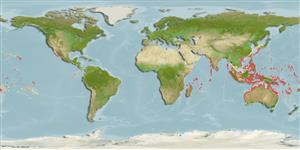>
Gobiiformes (Gobies) >
Gobiidae (Gobies) > Gobiinae
Etymology: Valenciennea: From Achille Valenciennes 1794-1865; he worked with Duméril, Cuvier and Lacepède since 1815; malacologist, author of a "Histoire naturelle des poissons" (Ref. 45335); parva: Species name from the Latin 'parvus', meaning dwarf..
More on authors: Hoese & Larson.
Environment: milieu / climate zone / depth range / distribution range
экология
морской ассоциированный с рифами; пределы глубины 1 - 20 m (Ref. 90102). Tropical
Indo-Pacific: Ashmore Reef, Maldives, and Seychelles to Oceania, north to Ryukyu Islands, south to the Great Barrier Reef.
Size / Вес / Возраст
Maturity: Lm ? range ? - ? cm
Max length : 10.0 cm SL самец/пол неопределен; (Ref. 48637)
колючие лучи спинного плавника (общее число): 6 - 7; членистые (мягкие) лучи спинного плавника (общее число): 12; колючие лучи анального плавника 1; членистые (мягкие) лучи анального плавника: 12. Characterized by pale grey body color; lower half of body with a pair of stripes linked by diffuse dark bars; faint dark grey bars/saddles on back; presence of blue-white stripe below eye to edge of gill opening, continued as white spot on upper pectoral fin base; without filamentous dorsal spines; rounded and short caudal fin, about equal to head length; longitudinal scale series 67-85; ctenoid body scales, becoming cycloid anteriorly below anterior part of first dorsal fin; without scales on head or midline of nape; side of nape with scales extending forward slightly anterior to above upper end of gill opening; scaleless pectoral fin base; partly scaled or scaleless prepelvic area; depth of body 5.7-6.6 in SL (Ref. 90102).
Inhabits coastal and inner reef sand flats and slopes, often in large lagoons (Ref. 48637). Found normally over clean, medium-grained sand patches interspersed with coral heads. It shares its habitat with the larger species such as V. longipinnis. Occurs in pairs or small groups and has been observed in burrows. Monogamous (Ref. 52884). Observed to rock back and forth when moving near the burrow.
Life cycle and mating behavior
половая зрелость | размножение | нерест | икра | Fecundity | личинки
Monogamous mating is observed as both obligate and social (Ref. 52884).
Hoese, D.F. and H.K. Larson, 1994. Revision of the Indo-Pacific gobiid fish genus Valenciennea, with descriptions of seven new species. Indo-Pac. Fish. (23):71 p. (Ref. 8527)
Статус Красного Списка МСОП (Ref. 130435)
Угроза для людей
Harmless
Использование человеком
дополнительная информация
ссылкиаквакультура (рыбоводство)особенности рыбоводствастепень растяжениягенетикаElectrophoresesнаследуемостьболезниобработкаNutrientsMass conversion
инструменты
Специальные отчеты
Скачать в формате XML
ресурсы в Интернет
Estimates based on models
Preferred temperature (Ref.
123201): 24.6 - 29.3, mean 28.3 °C (based on 2546 cells).
Phylogenetic diversity index (Ref.
82804): PD
50 = 0.5000 [Uniqueness, from 0.5 = low to 2.0 = high].
Bayesian length-weight: a=0.01023 (0.00477 - 0.02194), b=3.02 (2.84 - 3.20), in cm total length, based on LWR estimates for this (Sub)family-body shape (Ref.
93245).
Trophic level (Ref.
69278): 3.2 ±0.3 se; based on size and trophs of closest relatives
устойчивость к внешним воздействиям (Ref.
120179): высокий, минимальное время удвоения популяции до 15 месяцев (Preliminary K or Fecundity.).
Fishing Vulnerability (Ref.
59153): Low vulnerability (10 of 100).
Nutrients (Ref.
124155): Calcium = 118 [63, 235] mg/100g; Iron = 0.803 [0.422, 1.464] mg/100g; Protein = 18.4 [16.4, 20.1] %; Omega3 = 0.142 [0.066, 0.245] g/100g; Selenium = 20.3 [11.2, 39.2] μg/100g; VitaminA = 138 [38, 430] μg/100g; Zinc = 2.02 [1.36, 2.97] mg/100g (wet weight);
